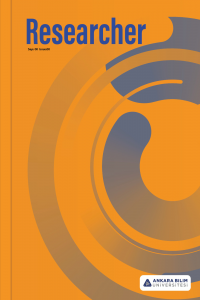Politikleştirilmiş Uzamda Huzursuzluğun Gösterimi: Paul Bowles’un TheSpider’s House Adlı Romanı
Bu makale, Paul Bowles’un The Spider’s House 1955 adlı romanında politikleştirilmiş Fez şehrinin yapısını kendi varlığı ve içinde yaşayan insanlar açısından çözümlemeyi amaçlar. Henri Lefebvre’in “mekan çalışmalarında dönüm noktası” hareketine yön veren uzam kuramı, uzamın fiziksel ve maddi olanı soyut ve toplumsal bileşenleriyle harmanlar ve onu bir değişim süreci içinde ele alır. Bu kuram romana uyar, çünkü Fez edilgen bir araç değildir; sömürge yönetimi altında durağan değil, kaygı verici olay ve durumların hızlandırıcı etmeni olarak devingendir. Bowles, Fez’i değiştirici/dönüştürücü olarak kavramlaştırır: şehir, yerli halkın mutsuzluğu ve eylemsizliğine yol açan mücadelenin nedenidir ve halkın saflıktan bozulmuşluğa dönüşmesine tanıklık eder. Fez, sosyo-politik olaylardan sorumludur ve bunlarda etkin pay sahibidir. Baskın rolüyle hem kendisinin, hem de insanların geleceğini biçimlendirir; ama ne sömürgeciye, ne de sömürülene refah vadeder. Huzursuzluğun resmidir: kimsesiz halkıyla kültürel kimliğini kaybetmiştir ve gelecek için bir değer oluşturamamaktadır. Jeopolitik durumu ve gizil güçleri, Fransız sömürgeci zihniyetinin dikkatini çeker ve güç ilişkilerinde mücadele alanı rolünü oynar. Öte yandan romanın başlığının işaret ettiği gibi politikleştirilmiş sömürge olan bir uzam olarak, bir örümcek ağına benzer: kırılgan, emniyetsiz ve kendine yabancı
Anahtar Kelimeler:
Paul Bowles, The Spider’s House, uzam, mekan çalışmalarında dönüm noktası, politikleştirilmiş şehir
The Representation of Unrest in the Politicized Space: Paul Bowles’ The Spider’s House
This article aims at analyzing the nature of the politicized city of Fez in terms of its own existence and the people inhabiting it in Paul Bowles’ The Spider’s House 1955 . Henri Lefebvre’s theory of space which leads to the “spatial turn” mingles the physical and material with the abstract and social components of space, and regards it in a process of change. It fits into the novel, because Fez is not a passive agent; under the colonial rule, it is not static, but dynamic, being the catalyst of ominous events and situations. Bowles conceptualizes Fez as transformative: it is the cause of conflict, which leads to the unhappiness and inaction of the native people and it witnesses the transformation of them from innocence to decadence. It is responsible for the socio-politic events and is the active participant of them. It has the dominant role and shapes the future of the people and its own, but it promises prosperity neither to the colonizer nor to the colonized. It is the very picture of unrest: it with its derelict people has lost its cultural identity and cannot constitute value for its future. With its geopolitical landscape and potentials, it draws the attention of French colonial mind and plays the role of the arena of the power relations, but as the title of the novel suggests, as a politicized colonized space, it becomes a spider’s house: fragile, insecure and alienated in itself
Keywords:
Paul Bowles, The Spider’s House, space, spatial turn, politicized city,
___
- Blank, Y; Rosen-Zvi, I. (2010). Introduction: The Spatial Turn in Social Theory. Hagar: Studies in Culture, Polity and Identities. 10(1), 1-6.
- Bowles, P. (1991). The Spider’s House. London: Abacus.
- Foucault, M. (1984). “Of Other Spaces: Utopias and Heterotopias” web.mit.edu/allanmc/www/foucault1.pdf (accessed on 03.07.2017)
- Lefebvre, H. (1978). Reflections on the Politics of Space. R. Peet (ed.) in Radical Geography: Alternative Viewpoints on Contemporary Social Issues. (pp. 339-52) London: Methuen.
- Lefebvre, H. (1991). The Production of Space. (Translated by Donald Nicholson-Smith). Oxford: Blackwell.
- Merriam-Webster (2018) https://www.merriam-webster.com/ (accessed on 07.06. 2018).
- Merriam –Webster Inc., (updated on 5th June).
- Moukhlis, S. (2015). The Spider's House. Interventions, 17(1), 24-44.
- DOI:10.1080/1369801X.2014.886157 (accessed on 24.May.2017)
- Purcell, M. (2014). Possible Worlds: Henri Lefebvre and the Right to the City. Journal of Urban Affairs. 36 (1), 141–154.
- ISSN: 0735-2166. DOI: 10.1111/juaf.12034 Soja, E. W. (2000). Thirdspace: Journeys to Los Angeles and Other Real-and Imagined Places. Malden: Blackwell Publishers Inc.
- Tyson, L. (2006). Critical Theory Today: A User-Friendly Guide. New York: Routledge.
- Walonen, M. K. (2009). Sense of Place in the North African Writings of Paul Bowles. M.B.
- Hackler (ed.) in On and Off the Page: Mapping Place in Text and Culture. (pp.9-30). New Castle upon Tyne: Cambridge.
- ISSN: 2717-9494
- Yayın Aralığı: Yılda 2 Sayı
- Başlangıç: 2013
- Yayıncı: Ankara Bilim Üniversitesi
Sayıdaki Diğer Makaleler
Eğitsel Oyun ve Drama Tekniklerinin Bilgisayar Donanımları Konusundaki Akademik Başarıya Etkisi
Mehmet Can ŞAHİN, Nihan ARSLAN NAMLI
Hüseyin GÜRBÜZ, Murat KARAPINAR
Elif KÖSE, Tennur YERLİSU LAPA
Non Toksik Metal Gravür Uygulamalarında Kullanılan Fotopolimer Film Solar Plaka Uygulamaları
İngilizce Öğretmen Adaylarının Dil Öğrenme Strateji Kullanımları
Arap Harfli Belâgat Kitaplarında İştikâk Sanatı ve Onun Cinasla İlişkisi
Zümre Öğretmenler Kurulu Toplantılarının Mesleki Gelişim Bağlamında İncelenmesi
